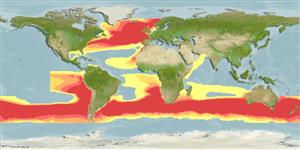Common names from other countries
>
Myctophiformes (Lanternfishes) >
Myctophidae (Lanternfishes) > Lampanyctinae
Etymology: Lampanyctus: Greek, lampas, -ados = torch + Greek, nykte = night (Ref. 45335).
Environment: milieu / climate zone / depth range / distribution range
Οικολογία
Θαλασσινό(ά) βαθυπελαγικό(ς); ωκεανόδρομο(ς) (Ref. 51243); εύρος βάθους 40 - 750 m (Ref. 4479). Deep-water; 68°N - 57°S, 180°W - 180°E
Northwest Atlantic: rare west of 50°W between 65°-32°N. Northeast Atlantic: Iceland and British Isles to the Mauritanian Upwelling Region; also in the southern Benguela Upwelling Region (Ref. 4066). Circumglobal in the southern hemisphere in the region of the Subtropical Convergence but with northern extension to about 18°S in eastern boundary currents.
Length at first maturity / Μέγεθος / Βάρος / Age
Maturity: Lm 16.9, range 17 - 17.2 cm
Max length : 20.0 cm SL αρσενικό/απροσδιόριστο; (Ref. 5182)
Short description
Κλείδες προσδιορισμού | Μορφολογία | Μορφομετρία
Ραχιαίες άκανθες (συνολικά) : 0; Μαλακές ραχιαίες ακτίνες (συνολικά) : 14 - 16; Εδρικές άκανθες: 0; Μαλακές εδρικές ακτίνες: 17 - 20.
Oceanic, mesopelagic (Ref. 4066), epipelagic to bathypelagic (Ref. 58426). Found between 550-750 m during the day; between 40-550 m at night (juveniles are most abundant in 75 m depth). Feeds on zooplankton (Ref. 58426).
Life cycle and mating behavior
Maturities | Αναπαραγωγή | Spawnings | Egg(s) | Fecundities | Προνύμφες
Hulley, P.A., 1990. Myctophidae. p. 398-467. In J.C. Quero, J.C. Hureau, C. Karrer, A. Post and L. Saldanha (eds.) Check-list of the fishes of the eastern tropical Atlantic (CLOFETA). JNICT, Lisbon; SEI; Paris; and UNESCO, Paris. Vol. 1. (Ref. 4479)
IUCN Red List Status (Ref. 130435)
CITES (Ref. 128078)
Not Evaluated
Threat to humans
Harmless
Human uses
Εργαλεία
Special reports
Download XML
Διαδικτυακές πηγές
Estimates based on models
Preferred temperature (Ref.
115969): 6.8 - 15.4, mean 10.3 (based on 418 cells).
Phylogenetic diversity index (Ref.
82804): PD
50 = 0.5000 [Uniqueness, from 0.5 = low to 2.0 = high].
Bayesian length-weight: a=0.00479 (0.00217 - 0.01054), b=3.16 (2.98 - 3.34), in cm Total Length, based on LWR estimates for this Genus-body shape (Ref.
93245).
Τροφικό Επίπεδο (Ref.
69278): 3.4 ±0.45 se; based on food items.
Ελαστικότητα (Ref.
120179): Μεσαίο(α), ελάχιστος χρόνος για διπλασιασμό πληθυσμού 1,4 - 4,4 έτη (Preliminary K or Fecundity.).
Fishing Vulnerability (Ref.
59153): Low vulnerability (14 of 100).
